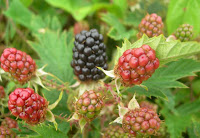Left American Robin nest (Turdus migratorius) photo S. Hochgraf, right Mourning Dove on nest (Zenaida macroura), photo L. Jones
Back in May I mentioned seeing young robins and doves out of the nest, and now, halfway through July, we are clearly into round two for some of the species. Earlier this week Lynn photographed a few of the more visible nests, and of course there are many concealed nests we'd love to find!
Left (or upper), Cedar Waxwing nest, right (or lower), young waxwing, which was first seen July 9th, still in the nest. (Bombycilla cedrorum) July 12th, photos L. Jones
For example - all of those goldfinches - where are they nesting? And today, for the first time, I saw not one, but two Willow Flycatchers - do they have a nest full of young? It's easiest to locate a nest when the parents are constantly back and forth bringing food, however the adult birds have a routine to deceive you (the perceived predator). Quiet patience is the key.
Left, thistles growing on a slope under White Pines, right, close-up of what is probably Canada Thistle. photos S. Hochgraf
Goldfinches usually begin nesting when the thistle flowers go to seed - the birds use the silky plant fibers for nest lining material and feed regurgitated thistle seeds to the nestlings. They are one of the few passerine birds to feed a largely plant-based diet to the young.
On a more somber note, there has been a rash of window strikes lately. Since last Friday, we've picked up four young birds below the glass corridors. Three of them dead - dove, robin and flicker, and one is on its way to a rehab center - a young Red-tailed Hawk. This morning the adult hawks were low over the parking lot, calling. We'll see how the little guy fares...
Okay, to wrap up this week of birding west campus:
How about a color code for nesting activity?
green = evidence of breeding: either adults bringing food or young birds out and about
purple = probably nesting, but we haven't seen the evidence yet
Wild Turkey, Meleagris gallopavo
Killdeer, Charadrius vociferus
Red-tailed Hawk, Buteo jamaicensis
Sharp-shinned Hawk, Accipiter striatusDouble-crested Cormorant, Phalacrocorax auritus
Rock Pigeon, Columba livia
Mourning Dove, Zenaida macroura
Downy Woodpecker, Picoides pubescensNorthern Flicker, Colaptes auratus
Chimney Swift, Chaetura pelagicaA rather yellow Cabbage White (Pieris rapae) on Canada Thistle (Cirsium arvense), photo S. Hochgraf
Willow Flycatcher, Empidonax traillii
American Crow, Corvus brachyrhynchosCedar Waxwing, Bombycilla cedrorum
American Robin, Turdus migratorius
Northern Mockingbird, Mimus polyglottosGray Catbird, Dumetella carolinensis
Carolina Wren, Thryothorus ludovicianus
House Wren, Troglodytes aedon
Barn Swallow, Hirundo rustica
Northern Rough-winged Swallow, Stelgidopteryx serripennis
European Starling, Sturnus vulgaris
Yellow Warbler, Dendroica petechia
Song Sparrow, Melospiza melodia
Chipping Sparrow, Spizella passerina
Common Grackle, Quiscalus quiscula Northern Cardinal, Cardinalis cardinalis
American Goldfinch, Carduelis tristis
House Finch, Carpodacus mexicanus
House Sparrow, Passer domesticusTwenty nine species for the week.
There is no blackberry pie in my future.





















